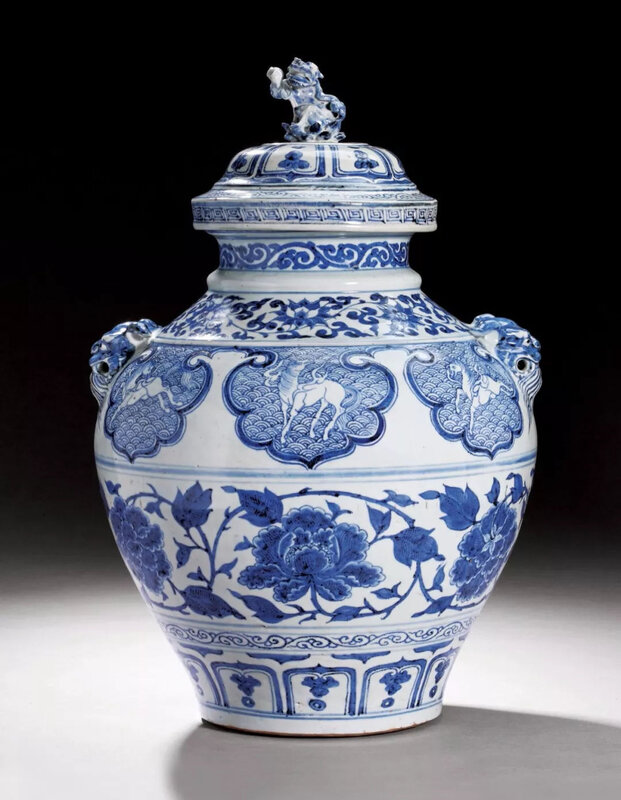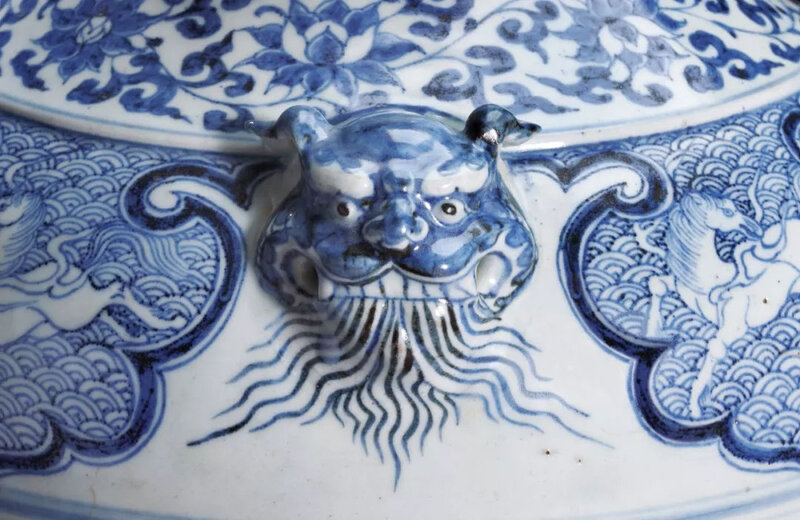An extremely rare and important blue and white jar and cover, Yuan dynasty (1279-1366)
Lot 2927. An extremely rare and important blue and white jar and cover, Yuan dynasty (1279-1366). Overall height 42cm., 16 1/2 in. Jar height 31.8cm., 12 1/2 in. Estimate 20,000,000 — 30,000,000 HKD. Lot sold 22,727,500 HKD (1,846,463 EUR) (2,917,984 USD). Courtesy Sotheby's 2008.
superbly potted, the wide shouldered baluster body rising to an upright neck and a galleried mouth, the body confidently painted in a spacious and dynamic composition masterfully balanced in carefully controlled cobalt-blue with a broad band of six scrolling peonies seen from the front, the side and the back, each bloom finely articulated with petals and leaves lightly incised to allow for subtle veining, all borne on a continous undulating leafy stem, below six cloud-shaped lappets, each containing a white flying haima ('sea horse') reserved on a wave ground, the shoulders further set with a pair of applied high-relief lion mask handles, the menacing-looking beasts each with a ferocious grin and long wispy painted beard, pierced on the side of the mouth to possibly hold a ring handle, the shoulders wreathed by a band of scrolling lotus flowers, all set between a row of classic scroll collaring the neck and another one encircling the foot above a band of upright lappets, fitted with a domed cover applied with an animated lion finial seated upon a lotus base, encircled by concentric bands of classic scroll and lappets.
Exhibited: Toyo no sometsuke, Mitsukoshi Department Store, Tokyo, 1977, cat.no.11.
So Gen no bijutsu, Osaka Municipal Art Museum, 1978, cat.no.1/225.
Gen no sometsuke ten/Exhibition of Blue and White Wares in Yuan Dynasty: 14th Century.
Ching-te Chen Wares, Museum of Oriental Ceramics, Osaka, 1985, cat.no.3.
Literature: Toji taikei, vol.41: Tokyo, 1974, col.pl.14.
Mayuyama: Seventy Years, vol.1, Tokyo, 1976, pl.684.
Sato Masahiko, Chugoku toji shi, Tokyo, 1978, translated as Chinese Ceramics. A Short History, New York, 1981, pl.228.
So Gen no bijutsu, Tokyo 1980, col.pl.1.
Sekai toji zenshu/Ceramic Art of the World, vol.13, Tokyo, 1981, col.pl.53.
Ye Peilan, Yuandai ciqi, Beijing, 1998, col.pl.58.
The Illustrious Flying Haima Jar
Regina Krahl
The present jar is one of the most published Yuan jars in private collections. Its design of white horses crossing waves is otherwise extremely rare and the animals are strikingly depicted in lively, naturalistic poses. Jars with covers are almost non-existent in private hands and the present cover, with its expressively modelled lion finial, is hard to match in any collection. Even the rendering of the peonies - a relatively common design on Yuan blue-and-white - is here particularly elaborate, with careful shading and finely combed detail.
Horses were in China revered as animals of perseverance and speed and pure white horses were particularly highly regarded. Horses played a major role at the Mongol court, which is also known for its predilection of the colour white. The unusual motif of white horses emitting flames and crossing waves is first seen on ceramics in the Yuan dynasty. According to lore, a dragon devoured the white horse of the Tang dynasty priest Xuanzang, who travelled to India to bring back Buddhist scriptures. On orders from Guanyin, the Goddess of Mercy, the dragon then had to turn himself into a white horse in order to carry back the sacred books. This association of the horse with the dragon probably explains the flames as well as the waves surrounding these horses.
A similar jar without cover, with the horses all galloping, and with two dragons replacing the lotus scroll at the shoulder, is preserved in the Topkapi Saray Museum, Istanbul, from the collection of the Ottoman Sultans, published in Regina Krahl, Chinese Ceramics from the Topkapi Saray Museum, Istanbul, London, 1986, vol.2, no.586, illustrated in colour p.407; also illustrated next to the present jar in Ye Peilan, op.cit., pl.59. Another jar without cover, of similar design but with petal panels around the shoulder is in the Ashmolean Museum, Oxford, illustrated in Sir Harry Garner, Oriental Blue and White, London, 1973 (1954), pl.21; and a third, also with petal panels but lacking its neck, from the collection of G. Rogers and later in a Japanese collection was sold in our London rooms, 3 December 1963, lot 93.
The design of white horses among waves appears also on a vase of meiping shape in the Topkapi Saray Museum, Istanbul, see Krahl, op.cit., no.585.
Two related jars with waterfowl and lotus similarly reserved in white in wave-filled panels, both missing neck and cover, were sold in our London rooms, 11 July 1967, lot 92, and 6 June 1995, lot 208, respectively; and two pairs of meiping vases with white lotus only among waves in ruyi-shaped panels were excavated in China, one from a hoard at Jurong, Jiangsu province, the other from the Gaoan hoard in Jiangxi, see Zhongguo ciqi quanji, vol.11, Shanghai, 2000, pls.139, 140, 143 and 146.
Covers with lion finials are extremely rare and the lions tend to be rendered much more simply; compare two covers with seated lions on top, one on a blue-and-white jar excavated at Huaian, Jiangsu province, the other on a blue-and-red decorated jar from the Baoding hoard in Hebei province, both illustrated in Ye Peilan, op.cit., pls.52 and 154.
Sotheby's. Fine Chinese Ceramics and Works of Art, Hong Kong, 11 Apr 2008

/https%3A%2F%2Fprofilepics.canalblog.com%2Fprofilepics%2F1%2F0%2F100183.jpg)
/https%3A%2F%2Fstorage.canalblog.com%2F03%2F02%2F119589%2F96711876_o.jpg)
/https%3A%2F%2Fstorage.canalblog.com%2F11%2F31%2F119589%2F94773502_o.jpg)
/https%3A%2F%2Fstorage.canalblog.com%2F20%2F83%2F119589%2F94772815_o.jpg)
/https%3A%2F%2Fstorage.canalblog.com%2F26%2F72%2F119589%2F75604929_o.jpg)
/https%3A%2F%2Fstorage.canalblog.com%2F59%2F60%2F119589%2F26458628_o.jpg)









/image%2F1371349%2F20240416%2Fob_2a8420_437713933-1652609748842371-16764302136.jpg)
/image%2F1371349%2F20240414%2Fob_83ee65_2024-nyr-22642-0954-000-a-blue-and-whi.jpg)
/image%2F1371349%2F20240414%2Fob_15808c_2024-nyr-22642-0953-000-a-blue-and-whi.jpg)
/image%2F1371349%2F20240414%2Fob_e54295_2024-nyr-22642-0952-000-a-rare-blue-an.jpg)